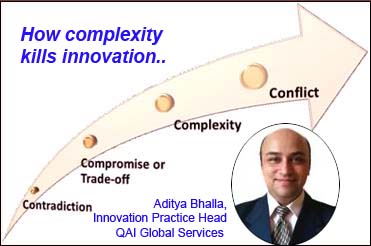
Incorrect handling of contradictions can create more complexity and sow the seeds for conflict within the organization. ADITYA BHALLA of QAI Global Services and TRIZ Asia Forum, suggests a systematic framework for addressing this challenge
There is a parable of a wood-cutter cutting a thick branch of a tree while seated on that branch. A passerby warns the wood-cutter that he would fall down with the cut branch but the simpleton wood-cutter ignores that advice and continues axing the branch. Eventually he does fall to the ground and is convinced that the passerby has divine powers.
The parable highlights the limitation of the human mind to do systems thinking and be surprised by outcomes that could have been otherwise easily foreseen through systematic thinking.
Human beings represent a kind of paradox: they prefer simplicity, but are fascinated by complexity and complex creations. Passive minds tend to add more complexity to address an apparently complex problem and hope for the market or organizational forces to resolve the end result. We see examples of that in every aspect around us including work places and processes designed within organizations.
The trick to being innovative lies in the ability to understand this limitation of the human mind and to make use of specific skills to ensure that we are able to cut through the complexity in any given situation.
Consider an example to illustrate how simple solutions to over-simplified representations of a situation end up creating more complexity than originally existed.
Performance appraisal bell-curve: One of the popular appraisal system requirements is to generate a performance “bell-curve” that rates 10% of staff as excellent performers, 10% as poor performers and the remaining in between. The positive intent of HR is to create an objective performance rating system based on merit.
But is the solution without its disadvantages? Let us take the case of a Head of Department handling specialized resources. The appraisal policy creates a contradiction for him as he would like to give top ratings to all his direct reports for having far exceeded the stiff performance targets set for them, but HR policy mandates that he follow the “bell-curve” performance appraisal system and rate 10% of his staff as poor performers.
The Head of Department approaches HR department to present his case but he is told that “the policy cannot be diluted and sacrificing a few good employees is an unfortunate reality of corporate life.”
From HR’s perspective even though they empathize with the limitations of the one-size-fits-all approach to performance appraisal they opt for a compromise or trade-off. However, the ripple effect that follows goes largely unseen by many in organizations.
The negative consequences of this trade-off can imply loss in employee morale and confidence (impacting their ability to perform), employee churn (which is a big loss in the long run) and other subtle ways of inimical human behaviour from an organization perspective. This places greater pressure on HR to create more complex systems to check and correct such inimical behaviour exhibited by employees. More complex systems however, only aggravate the negative behaviour as it now becomes a cat-and-mouse game between the “oppressed” and the “oppressor”.
Not identifying a contradiction or incorrect handling of contradictions can create more complexity and sow the seeds for conflict within the organization (between departments or within departments) or outside (with other stakeholders of the business ecosystem).
The figure accompanying this article, illustrates the path towards conflict through incorrect handling of contradictions or paradoxes encountered every day. Learning to generate win-win solutions is one of the core skills used by successful innovators whether they are confronted by an engineering problem (speed versus fuel consumption) or a service industry problem (hiring permanent employees versus temporary employees).
TRIZ (Russian acronym for Theory of Inventive Problem Solving) provides the systematic framework for understanding a given situation, revealing the hidden conflicts or paradoxes in that situation and generating win-win solutions to resolve the paradoxes.
Many organizations such as Intel, GE, P&G, Samsung, Hyundai, Pepsico, Cognizant and others have successfully applied the concepts to create a systematic framework for innovation management in product development as well as operational excellence.
Aditya Bhalla is Innovation Practice Head at QAI Global Services and President of TRIZ Asia Forum. He consults clients on product and process design and improvement. His clients include Vodafone, Metlife, Cognizant, Deloitte, Government of Singapore and many others. He can be contacted at adityabhalla@yahoo.com